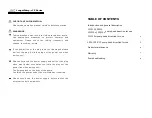
8
Fig. 4
Fig. 5
value of 3.87K
Ω
.
T h e a c t u a l
value of resis-
tance is 3.87K
Ω
and not 4K
Ω
that was mea-
sured in the
200K
Ω
range.
This is very im-
p o r t a n t b e -
cause if the
manufacturer
specifications
say that the
sensor should
read 3.8-3.9K
Ω
at 70°F then on
t h e 2 0 0 K
Ω
range the sensor would be defective, but
at the 20K
Ω
range it would test good.
Now set the multimeter to the 2K
Ω
range.
(See Fig. 6) The
display will indi-
c a t e
a n
overrange con-
dition because
3.87K
Ω
is larger
than 2K
Ω
.
This example
shows that by
decreasing the
range you in-
crease the ac-
curacy of your
measurement.
W h e n y o u
c h a n g e t h e
r a n g e , y o u
change the lo-
cation of the decimal point. This changes
Fig. 6
the accuracy of the measurement by ei-
ther increasing or decreasing the number
of digits after the decimal point.
Battery and Fuse
Replacement
Important: A 9 Volt battery must be in-
s t a l l e d b e f o r e u s i n g t h e d i g i t a l
multimeter. (see procedure below for
installation)
Battery Replacement
1. Turn multimeter OFF.
2. Remove test leads from
multimeter.
3. Remove screw from battery
cover.
4. Remove battery cover.
5. Install a new 9 Volt battery.
6. Re-assemble multimeter.
Fuse Replacement
1.
Turn multimeter OFF.
2.
Remove test leads from
multimeter.
3.
Remove rubber holster.
4.
Remove screw from battery
cover, battery cover, and battery.
5.
Remove screws from back of
multimeter.
6.
Remove back cover.
7.
Remove fuse.
8.
Replace fuse with same size
and type as originally installed.
Fuse 1:
A,
0V fast type
ceramic fuse
x 2mm.
Fuse 2: 10A,
0V, fast type,
ceramic fuse, Ø
5 x
mm.
9.
Re-assemble multimeter.
WARNING:
To avoid electric shock, make sure
the probes are disconnected from the
measured circuit before removing the
rear cover. Make sure the rear cover
is tightly screwed before using the
instrument.
OL
600
600
600
600
600
600
®
®
®









































